differential Seat Ibiza SC 2011 Owner's manual
[x] Cancel search | Manufacturer: SEAT, Model Year: 2011, Model line: Ibiza SC, Model: Seat Ibiza SC 2011Pages: 278, PDF Size: 3.92 MB
Page 70 of 278
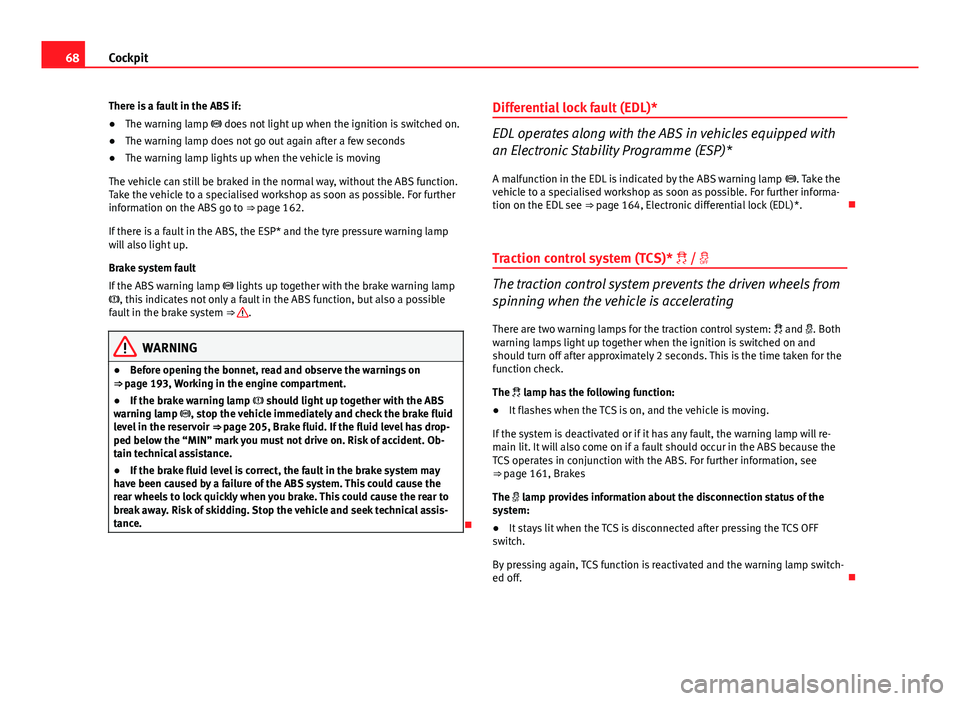
68Cockpit
There is a fault in the ABS if:
● The warning lamp does not light up when the ignition is switched on.
● The warning lamp does not go out again after a few seconds
● The warning lamp lights up when the vehicle is moving
The vehicle can still be braked in the normal way, without the ABS function.
Take the vehicle to a specialised workshop as soon as possible. For further
information on the ABS go to ⇒ page 162.
If there is a fault in the ABS, the ESP* and the tyre pressure warning lamp
will also light up.
Brake system fault
If the ABS warning lamp lights up together with the brake warning lamp
, this indicates not only a fault in the ABS function, but also a possible
fault in the brake system ⇒
.
WARNING
● Before opening the bonnet, read and observe the warnings on
⇒ page 193, Working in the engine compartment.
● If the brake warning lamp should light up together with the ABS
warning lamp , stop the vehicle immediately and check the brake fluid
level in the reservoir ⇒ page 205, Brake fluid. If the fluid level has drop-
ped below the “MIN” mark you must not drive on. Risk of accident. Ob-
tain technical assistance.
● If the brake fluid level is correct, the fault in the brake system may
have been caused by a failure of the ABS system. This could cause the
rear wheels to lock quickly when you brake. This could cause the rear to
break away. Risk of skidding. Stop the vehicle and seek technical assis-
tance.
Differential lock fault (EDL)*
EDL operates along with the ABS in vehicles equipped with
an Electronic Stability Programme (ESP)*
A malfunction in the EDL is indicated by the ABS warning lamp . Take the
vehicle to a specialised workshop as soon as possible. For further informa-
tion on the EDL see ⇒ page 164, Electronic differential lock (EDL)*.
Traction control system (TCS)* /
The traction control system prevents the driven wheels from
spinning when the vehicle is accelerating
There are two warning lamps for the traction control system: and . Both
warning lamps light up together when the ignition is switched on and
should turn off after approximately 2 seconds. This is the time taken for the
function check.
The lamp has the following function:
● It flashes when the TCS is on, and the vehicle is moving.
If the system is deactivated or if it has any fault, the warning lamp will re-
main lit. It will also come on if a fault should occur in the ABS because the
TCS operates in conjunction with the ABS. For further information, see
⇒ page 161, Brakes
The lamp provides information about the disconnection status of the
system:
● It stays lit when the TCS is disconnected after pressing the TCS OFF
switch.
By pressing again, TCS function is reactivated and the warning lamp switch-
ed off.
Page 138 of 278
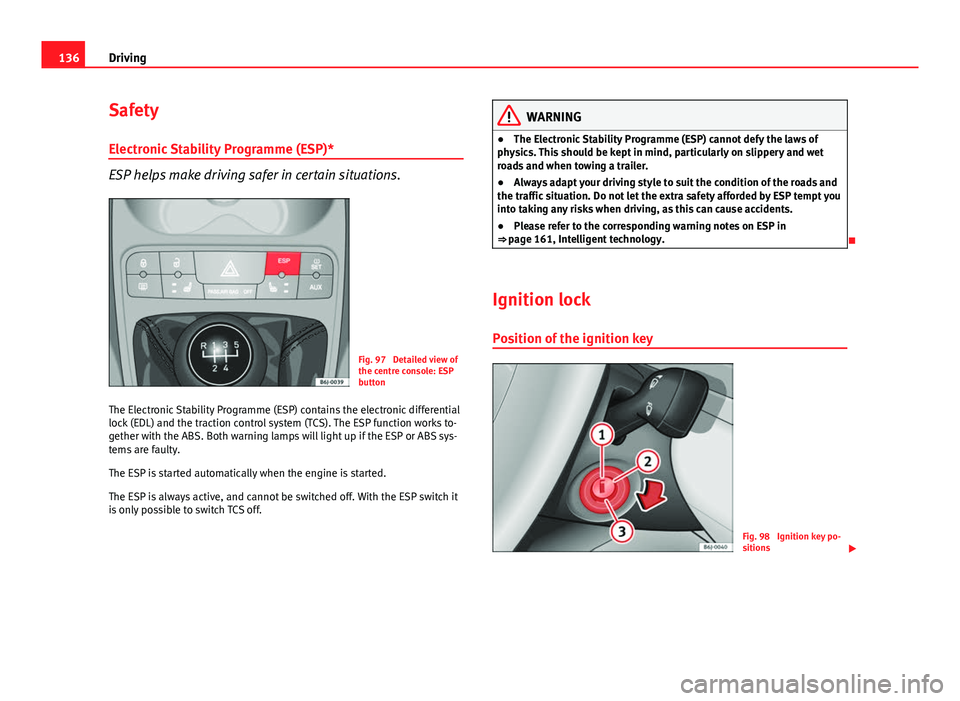
136Driving
Safety
Electronic Stability Programme (ESP)*
ESP helps make driving safer in certain situations.
Fig. 97 Detailed view of
the centre console: ESP
button
The Electronic Stability Programme (ESP) contains the electronic differential
lock (EDL) and the traction control system (TCS). The ESP function works to-
gether with the ABS. Both warning lamps will light up if the ESP or ABS sys-
tems are faulty.
The ESP is started automatically when the engine is started.
The ESP is always active, and cannot be switched off. With the ESP switch it
is only possible to switch TCS off.
WARNING
● The Electronic Stability Programme (ESP) cannot defy the laws of
physics. This should be kept in mind, particularly on slippery and wet
roads and when towing a trailer.
● Always adapt your driving style to suit the condition of the roads and
the traffic situation. Do not let the extra safety afforded by ESP tempt you
into taking any risks when driving, as this can cause accidents.
● Please refer to the corresponding warning notes on ESP in
⇒ page 161, Intelligent technology.
Ignition lock Position of the ignition key
Fig. 98 Ignition key po-
sitions
Page 165 of 278
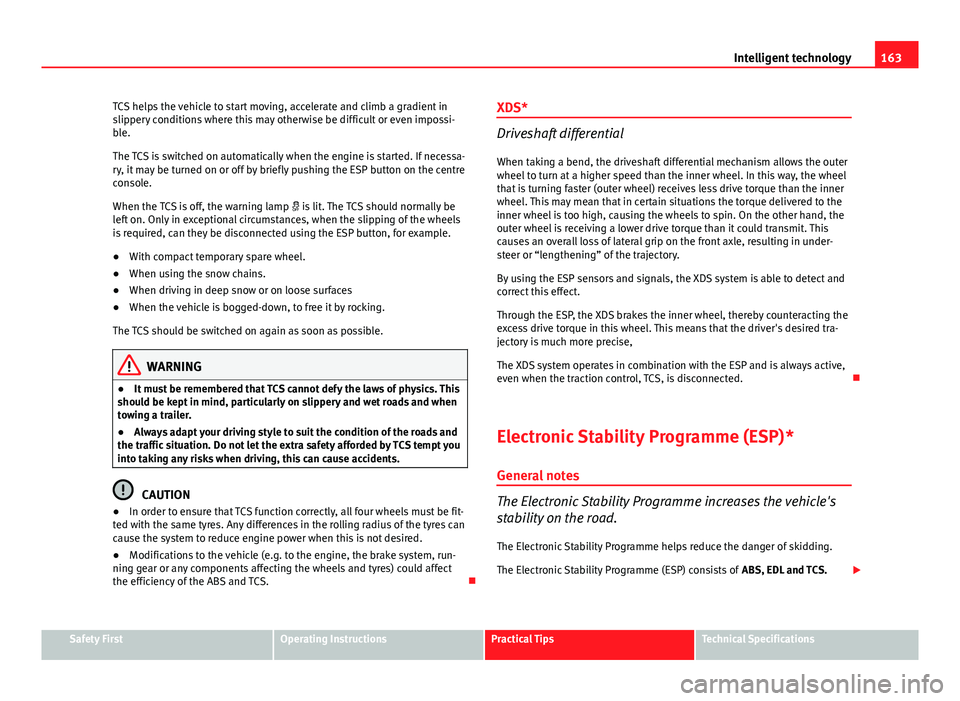
163
Intelligent technology
TCS helps the vehicle to start moving, accelerate and climb a gradient in
slippery conditions where this may otherwise be difficult or even impossi-
ble.
The TCS is switched on automatically when the engine is started. If necessa-
ry, it may be turned on or off by briefly pushing the ESP button on the centre
console.
When the TCS is off, the warning lamp is lit. The TCS should normally be
left on. Only in exceptional circumstances, when the slipping of the wheels
is required, can they be disconnected using the ESP button, for example.
● With compact temporary spare wheel.
● When using the snow chains.
● When driving in deep snow or on loose surfaces
● When the vehicle is bogged-down, to free it by rocking.
The TCS should be switched on again as soon as possible.
WARNING
● It must be remembered that TCS cannot defy the laws of physics. This
should be kept in mind, particularly on slippery and wet roads and when
towing a trailer.
● Always adapt your driving style to suit the condition of the roads and
the traffic situation. Do not let the extra safety afforded by TCS tempt you
into taking any risks when driving, this can cause accidents.
CAUTION
● In order to ensure that TCS function correctly, all four wheels must be fit-
ted with the same tyres. Any differences in the rolling radius of the tyres can
cause the system to reduce engine power when this is not desired.
● Modifications to the vehicle (e.g. to the engine, the brake system, run-
ning gear or any components affecting the wheels and tyres) could affect
the efficiency of the ABS and TCS. XDS*
Driveshaft differential
When taking a bend, the driveshaft differential mechanism allows the outer
wheel to turn at a higher speed than the inner wheel. In this way, the wheel
that is turning faster (outer wheel) receives less drive torque than the inner
wheel. This may mean that in certain situations the torque delivered to the
inner wheel is too high, causing the wheels to spin. On the other hand, the
outer wheel is receiving a lower drive torque than it could transmit. This
causes an overall loss of lateral grip on the front axle, resulting in under-
steer or “lengthening” of the trajectory.
By using the ESP sensors and signals, the XDS system is able to detect and
correct this effect.
Through the ESP, the XDS brakes the inner wheel, thereby counteracting the
excess drive torque in this wheel. This means that the driver's desired tra-
jectory is much more precise,
The XDS system operates in combination with the ESP and is always active,
even when the traction control, TCS, is disconnected.
Electronic Stability Programme (ESP)* General notes
The Electronic Stability Programme increases the vehicle's
stability on the road.
The Electronic Stability Programme helps reduce the danger of skidding.
The Electronic Stability Programme (ESP) consists of ABS, EDL and TCS.
Safety FirstOperating InstructionsPractical TipsTechnical Specifications
Page 166 of 278
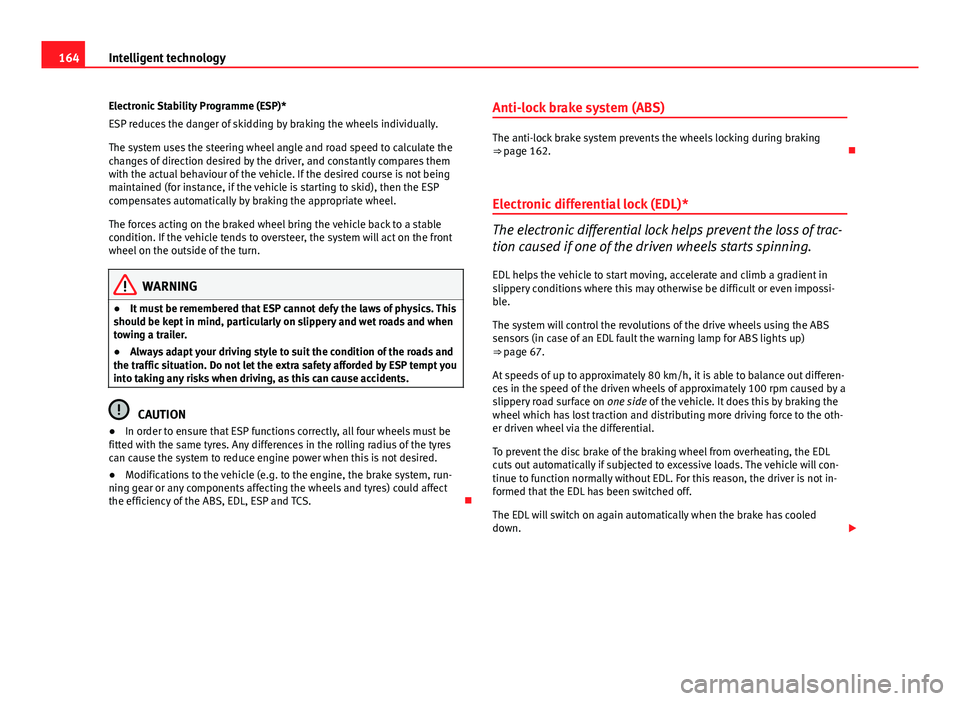
164Intelligent technology
Electronic Stability Programme (ESP)*
ESP reduces the danger of skidding by braking the wheels individually.
The system uses the steering wheel angle and road speed to calculate the
changes of direction desired by the driver, and constantly compares them
with the actual behaviour of the vehicle. If the desired course is not being
maintained (for instance, if the vehicle is starting to skid), then the ESP
compensates automatically by braking the appropriate wheel.
The forces acting on the braked wheel bring the vehicle back to a stable
condition. If the vehicle tends to oversteer, the system will act on the front
wheel on the outside of the turn.
WARNING
● It must be remembered that ESP cannot defy the laws of physics. This
should be kept in mind, particularly on slippery and wet roads and when
towing a trailer.
● Always adapt your driving style to suit the condition of the roads and
the traffic situation. Do not let the extra safety afforded by ESP tempt you
into taking any risks when driving, as this can cause accidents.
CAUTION
● In order to ensure that ESP functions correctly, all four wheels must be
fitted with the same tyres. Any differences in the rolling radius of the tyres
can cause the system to reduce engine power when this is not desired.
● Modifications to the vehicle (e.g. to the engine, the brake system, run-
ning gear or any components affecting the wheels and tyres) could affect
the efficiency of the ABS, EDL, ESP and TCS. Anti-lock brake system (ABS)
The anti-lock brake system prevents the wheels locking during braking
⇒ page 162.
Electronic differential lock (EDL)*
The electronic differential lock helps prevent the loss of trac-
tion caused if one of the driven wheels starts spinning.
EDL helps the vehicle to start moving, accelerate and climb a gradient in
slippery conditions where this may otherwise be difficult or even impossi-
ble.
The system will control the revolutions of the drive wheels using the ABS
sensors (in case of an EDL fault the warning lamp for ABS lights up)
⇒ page 67.
At speeds of up to approximately 80 km/h, it is able to balance out differen-
ces in the speed of the driven wheels of approximately 100 rpm caused by a
slippery road surface on one side of the vehicle. It does this by braking the
wheel which has lost traction and distributing more driving force to the oth-
er driven wheel via the differential.
To prevent the disc brake of the braking wheel from overheating, the EDL
cuts out automatically if subjected to excessive loads. The vehicle will con-
tinue to function normally without EDL. For this reason, the driver is not in-
formed that the EDL has been switched off.
The EDL will switch on again automatically when the brake has cooled
down.
Page 271 of 278
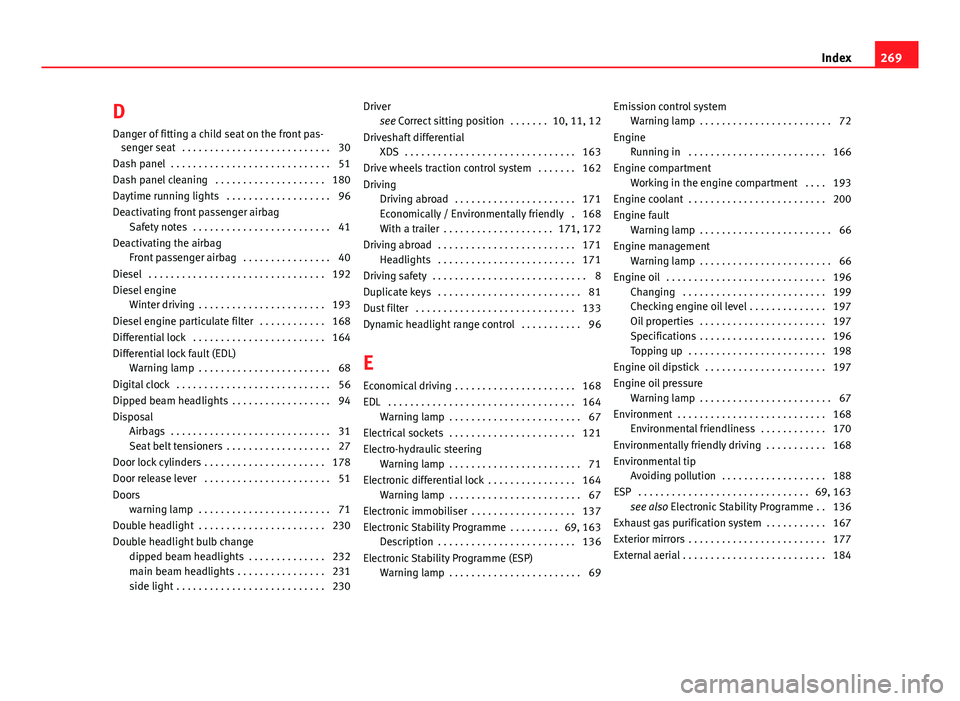
D
Danger of fitting a child seat on the front pas- senger seat . . . . . . . . . . . . . . . . . . . . . . . . . . . 30
Dash panel . . . . . . . . . . . . . . . . . . . . . . . . . . . . . 51
Dash panel cleaning . . . . . . . . . . . . . . . . . . . . 180
Daytime running lights . . . . . . . . . . . . . . . . . . . 96
Deactivating front passenger airbag Safety notes . . . . . . . . . . . . . . . . . . . . . . . . . 41
Deactivating the airbag Front passenger airbag . . . . . . . . . . . . . . . . 40
Diesel . . . . . . . . . . . . . . . . . . . . . . . . . . . . . . . . 192
Diesel engine Winter driving . . . . . . . . . . . . . . . . . . . . . . . 193
Diesel engine particulate filter . . . . . . . . . . . . 168
Differential lock . . . . . . . . . . . . . . . . . . . . . . . . 164
Differential lock fault (EDL) Warning lamp . . . . . . . . . . . . . . . . . . . . . . . . 68
Digital clock . . . . . . . . . . . . . . . . . . . . . . . . . . . . 56
Dipped beam headlights . . . . . . . . . . . . . . . . . . 94
Disposal Airbags . . . . . . . . . . . . . . . . . . . . . . . . . . . . . 31
Seat belt tensioners . . . . . . . . . . . . . . . . . . . 27
Door lock cylinders . . . . . . . . . . . . . . . . . . . . . . 178
Door release lever . . . . . . . . . . . . . . . . . . . . . . . 51
Doors warning lamp . . . . . . . . . . . . . . . . . . . . . . . . 71
Double headlight . . . . . . . . . . . . . . . . . . . . . . . 230
Double headlight bulb change dipped beam headlights . . . . . . . . . . . . . . 232
main beam headlights . . . . . . . . . . . . . . . . 231
side light . . . . . . . . . . . . . . . . . . . . . . . . . . . 230 Driver
see Correct sitting position . . . . . . . 10, 11, 12
Driveshaft differential XDS . . . . . . . . . . . . . . . . . . . . . . . . . . . . . . . 163
Drive wheels traction control system . . . . . . . 162
Driving Driving abroad . . . . . . . . . . . . . . . . . . . . . . 171
Economically / Environmentally friendly . 168
With a trailer . . . . . . . . . . . . . . . . . . . . 171, 172
Driving abroad . . . . . . . . . . . . . . . . . . . . . . . . . 171 Headlights . . . . . . . . . . . . . . . . . . . . . . . . . 171
Driving safety . . . . . . . . . . . . . . . . . . . . . . . . . . . . 8
Duplicate keys . . . . . . . . . . . . . . . . . . . . . . . . . . 81
Dust filter . . . . . . . . . . . . . . . . . . . . . . . . . . . . . 133
Dynamic headlight range control . . . . . . . . . . . 96
E
Economical driving . . . . . . . . . . . . . . . . . . . . . . 168
EDL . . . . . . . . . . . . . . . . . . . . . . . . . . . . . . . . . . 164 Warning lamp . . . . . . . . . . . . . . . . . . . . . . . . 67
Electrical sockets . . . . . . . . . . . . . . . . . . . . . . . 121
Electro-hydraulic steering Warning lamp . . . . . . . . . . . . . . . . . . . . . . . . 71
Electronic differential lock . . . . . . . . . . . . . . . . 164 Warning lamp . . . . . . . . . . . . . . . . . . . . . . . . 67
Electronic immobiliser . . . . . . . . . . . . . . . . . . . 137
Electronic Stability Programme . . . . . . . . . 69, 163 Description . . . . . . . . . . . . . . . . . . . . . . . . . 136
Electronic Stability Programme (ESP) Warning lamp . . . . . . . . . . . . . . . . . . . . . . . . 69 Emission control system
Warning lamp . . . . . . . . . . . . . . . . . . . . . . . . 72
Engine Running in . . . . . . . . . . . . . . . . . . . . . . . . . 166
Engine compartment Working in the engine compartment . . . . 193
Engine coolant . . . . . . . . . . . . . . . . . . . . . . . . . 200
Engine fault Warning lamp . . . . . . . . . . . . . . . . . . . . . . . . 66
Engine management Warning lamp . . . . . . . . . . . . . . . . . . . . . . . . 66
Engine oil . . . . . . . . . . . . . . . . . . . . . . . . . . . . . 196 Changing . . . . . . . . . . . . . . . . . . . . . . . . . . 199
Checking engine oil level . . . . . . . . . . . . . . 197
Oil properties . . . . . . . . . . . . . . . . . . . . . . . 197
Specifications . . . . . . . . . . . . . . . . . . . . . . . 196
Topping up . . . . . . . . . . . . . . . . . . . . . . . . . 198
Engine oil dipstick . . . . . . . . . . . . . . . . . . . . . . 197
Engine oil pressure Warning lamp . . . . . . . . . . . . . . . . . . . . . . . . 67
Environment . . . . . . . . . . . . . . . . . . . . . . . . . . . 168 Environmental friendliness . . . . . . . . . . . . 170
Environmentally friendly driving . . . . . . . . . . . 168
Environmental tip Avoiding pollution . . . . . . . . . . . . . . . . . . . 188
ESP . . . . . . . . . . . . . . . . . . . . . . . . . . . . . . . 69, 163 see also Electronic Stability Programme . . 136
Exhaust gas purification system . . . . . . . . . . . 167
Exterior mirrors . . . . . . . . . . . . . . . . . . . . . . . . . 177
External aerial . . . . . . . . . . . . . . . . . . . . . . . . . . 184
269
Index